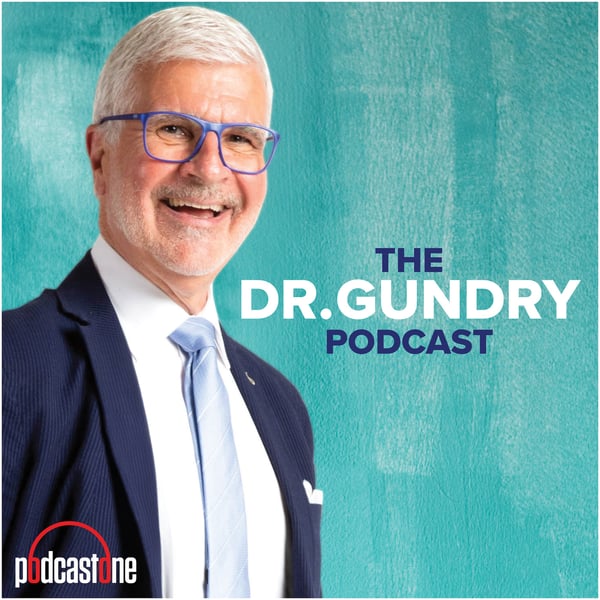Dr. G's Quick Health Tip: Top 3 Vitamin D MYTHS | EP 249.B
The Dr. Gundry Podcast
PodcastOne
4.6 • 1.7K Ratings
🗓️ 6 April 2023
⏱️ 14 minutes
🧾️ Download transcript
Summary
Transcript
Click on a timestamp to play from that location
| 0:00.0 | Welcome to the Dr. Gundry Podcast, the weekly podcast where Dr. G gives you the tools you need to boost your health and live your healthiest life. |
| 0:14.0 | Dr. Gundry here with a short and sweet episode where I reveal some of the newest cutting-edge research that can improve your health in just minutes. |
| 0:23.0 | Hey, this is Dr. Gundry. The three things you should know about vitamin D that will surprise you. |
| 0:32.0 | Number one, the vast majority of people, even in sunny climates, don't get enough vitamin D. In fact, studies in Southern California showed that 80% of Southern Californians were deficient in vitamin D. |
| 0:46.0 | 80% of Southern Californians, right here. Why is that in Southern California? You might ask because we're all addicted to sunscreens, quite frankly, and we'll talk about getting rid of sunscreens in just a minute. |
| 1:00.0 | In Brooklyn, New York, 84% of people were vitamin D deficient. That means they were below the threshold that the federal government recommends as vitamin D levels. |
| 1:15.0 | Now, vitamin D deficiency is actually less than 30 nanograms per milliliter. In my practice, my bare minimum for vitamin D levels is 80 nanograms per milliliter. |
| 1:30.0 | So, they're way, way off. Now, why is it impossible to get enough vitamin D in our food? |
| 1:37.0 | First of all, most foods don't have a lot of vitamin D. Interestingly enough, mushrooms are the highest source of vitamin D. |
| 1:46.0 | And as I've talked about in previous YouTube videos, you can't get enough mushrooms into your diet. Now, how do you get vitamin D? Well, sun exposure is the easy way. |
| 1:57.0 | Believe it or not, I grew up at a time when there wasn't no such thing as sunscreen. And like in places that still do not use sunscreen, we basically build up a callus of sun exposure by slowly introducing sun in the middle of the day for 15 minutes. |
| 2:18.0 | And quite frankly, my mother and father would send us out, kind of set a timer in our swimsuits in the backyard or at the pool and expose us for like 15 minutes a day at the top of the sun. |
| 2:33.0 | Then we'd cover up or we'd go back inside and each day we'd get out longer and longer. And many cultures that do not use sunscreen still use this traditional practice. |
| 2:45.0 | Now, there's a professor at Boston University, Dr. Hollick, who's really one of the fathers of vitamin D. And he became infamous as a dermatologist for recommending that people get full sun exposure and to ditch the sunscreens. |
| 3:03.0 | Now, he was way ahead of his time and it turns out that sun exposure is really one of the most important ways to make vitamin D. And that cultures that do get sun exposure, interestingly enough, live a very long time. |
| 3:20.0 | Here's a fun fact that most people don't put together. All five of the blue zones, those areas of the world that Dan Buckner described in the blue zone books. |
| 3:31.0 | All of those are in high sun exposure areas, including where I practice for most of my life, Loma Linda, California, the only blue zone in the United States. |
| 3:44.0 | All the other blue zones are in very similar latitudes, Okinawa, Japan, the Costa Rica, Sardinia, and Greece. |
| 3:56.0 | All of these are in sun exposed latitudes, and that ought to tell you something. In fact, the French government believes that the idea that the grape growing regions of France correlate with good health also explains where olive trees can grow. |
| 4:16.0 | And olive trees follow the sun, and most olive trees can't grow above a particular parallel. So if you've got olive trees growing, you're in the right place to get sun exposure. |
| 4:29.0 | Now, it's very hard to overdo vitamin D. Studies at the University of California, San Diego, another center that's dedicated to studying vitamin D. |
| 4:40.0 | Have shown that the average American, get this, the average American, to have adequate vitamin D levels to prevent cancer and to improve longevity should have 9,600 international units a day. |
... |
Please login to see the full transcript.
Disclaimer: The podcast and artwork embedded on this page are from PodcastOne, and are the property of its owner and not affiliated with or endorsed by Tapesearch.
Generated transcripts are the property of PodcastOne and are distributed freely under the Fair Use doctrine. Transcripts generated by Tapesearch are not guaranteed to be accurate.
Copyright © Tapesearch 2025.

